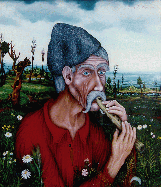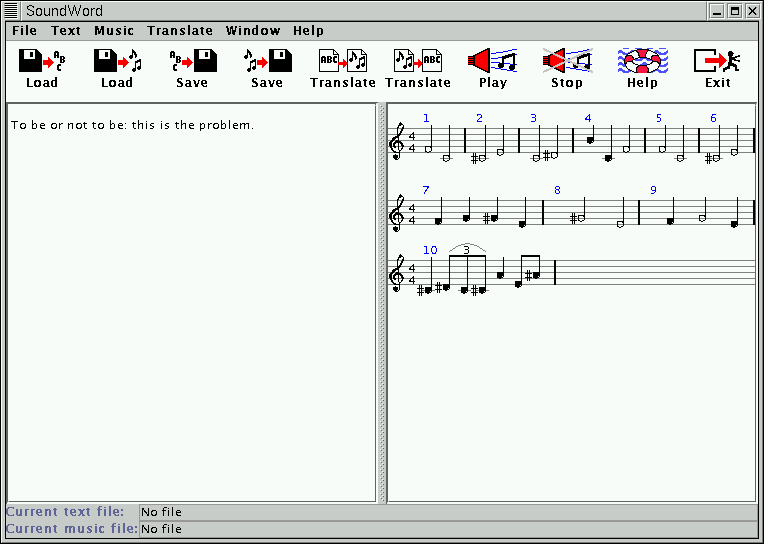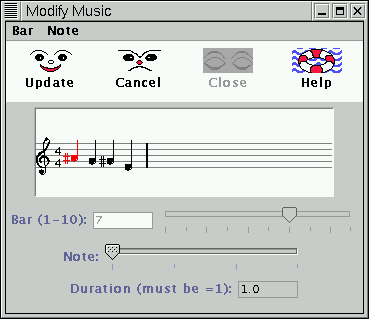SoundWord

A program designed by Giuseppina Mancuso and
implemented by Paola Magillo
(C) Worldwide Copyright - All rights reserved
Instructions for use of SoundWord
The following instructions for using SoundWord are also
included in the program as an help-on-line.
The main window
SoundWord initially shows a window containing the containing
the program icon and the copyright notice.
After a few seconds, the main window of SoundWord appears.
The main window of SoundWord is organized in the following way:
- A menu bar (on top).
- A set of buttons that replicate the most commonly used functions
of the menus (just under the menu bar).
- A central area divided into two parts (you can choice between a vertical
or a horizontal subdivision by the "Window" menu).
The left (or top) area contains the current text.
The right (or bottom) area contains the current music.
- Two frames on the bottom showing the names of the current text file and
of the current music file (if the current text or music have been loaded
from or saved to a file).

Text area
You can type directly in the text area, load a text from a file, or obtain a
text from translating a music.
The current text can be translated into music by using the "Translate" menu.
Music area
You can obtain a music from translating a text, or you can load it from a
file (in SoundWord format). The blue numbers denote the progression of bars.
The current music can be translated back into a text by using the
"Translate" menu.
Menu bar
"File" menu: load and save either a text or a music.
- "Clear": clean either the text area or the music area.
- "Load": load a text or music from file.
- "Save": save the text or the music on the file whose name is shown in the bottom of the window.
- "Save as": save either the text or the music, asking for a file name.
The format of music files loaded and saved is an internal format of SoundWord.
- "Save MIDI file" saves the music on a file in standard music format "MIDI" (Musical Instrument Digital Interface), which can be played by other commercial programs.
"Text" menu: operations on the text contained in the text area.
- "Larger/smaller": diplay text in larger/smaller fonts.
- "Select all": select all the text for subsequent operations.
- "Copy": record selected text for duplicating it.
- "Cut": erase selected text. If the text has been recorded, it
remains recorded and can still be duplicated.
- "Paste": insert a copy of the recorded text (not of the selected text!)
at the cursor position.
You can also edit the text by using directly the keyboard after placing the
cursor in the text area.
"Music" menu: operations on the music contained in the music area.
- "Larger/smaller": diplay music in larger/smaller fonts.
- "Modify": open a secondary window containing functions to edit the music
(see separate instructions).
- "Play": play the music.
- "Stop": stop playing the music.
- "Speed": set the speed for playing music. It is also applied to Midi
files (see File menu).
- "Accompaniment": set the type of accompaniment for playing music. It
affects also Midi files (see File menu).
"Window" menu: set the vertical or horizontal subdivision of the main
window.
"Translate" menu: translation between text and music.
- "Text to music": translate the text contained in the text area into music. The music obtained from the translation is shown in the music area. If such area already contained some music, the new music coming from the translation replaces it.
- "Music to text": translate the music contained in the music area,
with a symmetric behavior.
The translation of a text into a music is not unique. Translating the same
text several times gives slightly different musics.
The difference is in the displacement of note lengths inside a bar.
"Help" menu: display helpful information.
- "Version": information about program version, authors, and copyright
notice.
- "Purpose": explain the purpose of the SoundWord.
- "How to use": guide for using SoundWord.
- "Editing music": specific instructions for editing a music produced
by SoundWord.
- "Notes & keyboard": show the graphical representation of the 12 notes
on the keyboard and on the staff.
Information related with the last four items above are shown in a
secondary window organized into cards.
The "Modify current music" window
Selecting "Modify", from the "Music" menu on the main window, opens a
secondary window which allows modifying the music contained in the music
area, or writing music from scratch.
This window presents:
- A menu bar.
- Four buttons located under the menu bar.
- A graphic area (in the middle) containing the music bar that is
being modified.
- Some control devices located under the graphic area.

Menu bar
"Bar" menu: adding, selecting and deleting bars.
- "Browse bars": select a bar of the music.
The selected bar is shown in the underlying graphic area.
Selecting a bar is the first step in order to modify or erase it (see below).
- "Add bar at end": add a new bar at the end of the music.
This bar initially contains just one note (DO = C) whose duration is 4/4.
- "Erase this bar": erase the selected bar, that is the one shown in
the graphic area.
You can also select a bar by inserting its number in the frame located
under the nemu bar, or by acting on the slider located near the frame.
The bar numbers are shown in blue in the music area of the main window.
"Note" menu: modifying the selected bar.
In any instant one note within the bar is enlightened in red.
This is the node on which modifications will act.
You cannot add or delete single notes to the bar.
Instead, you can add or delete groups of notes.
Here by group we mean a sequence of notes that are drawn with a single
stroke without detaching the pencil (for instance: a triplet of notes
joined by a transversal line).
- "Change note...": change the value of the red note.
- "Browse notes...": shif the red note.
As an alternative, we can also shift the red note by using the two arrows
located under the menu bar.
- "Add group at end": adds a new group of chosen type.
The group is added at the end of the bar and initially all notes are DO (= C).
- "Erase this group": erases the group containing the red note.
The modifications are applied to the selected bar in the music (shown in the
main window) only after pressing the "Update" button (smiling face).
You can also cancel the modifications by pressing the "Cancel" button (sad
face).
Adding and deleting groups to and from the bar can temporarily give a total
duration different from 4/4 (=1).
You cannot press the "Update" button, nor shift to other bars, until the bar
duration becomes 4/4 again.
The frame located just above the graphic area shows the current bar
duration.
Back to main page.



